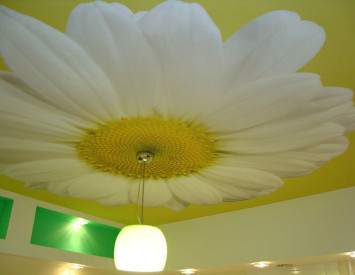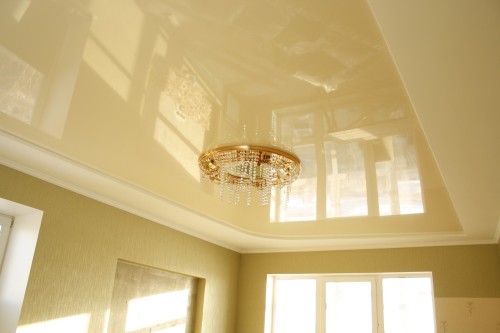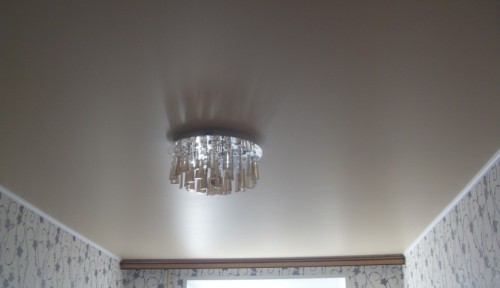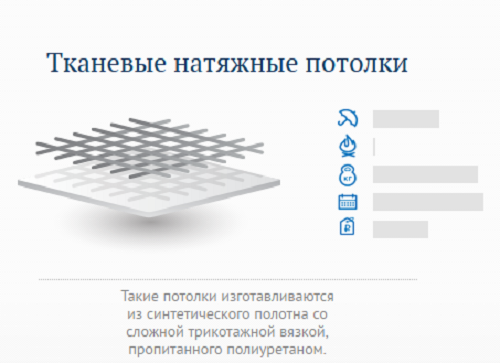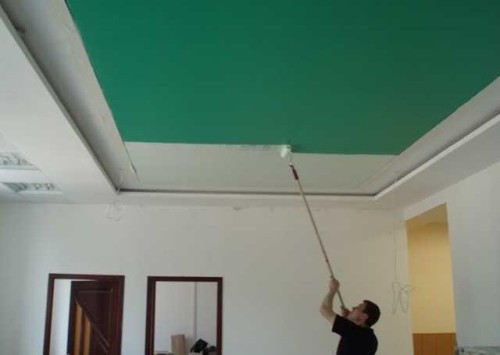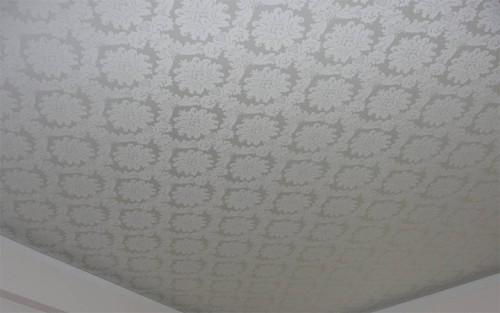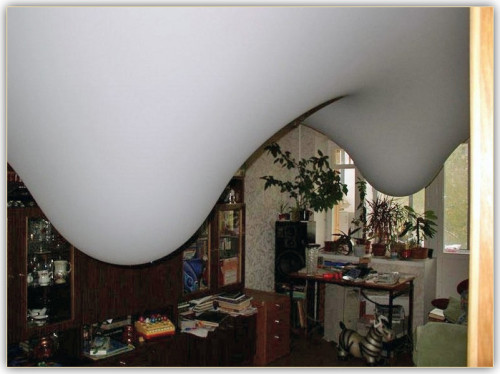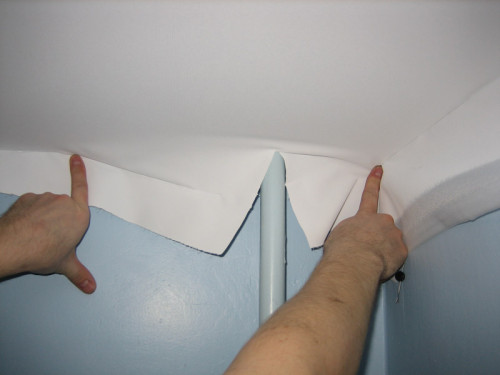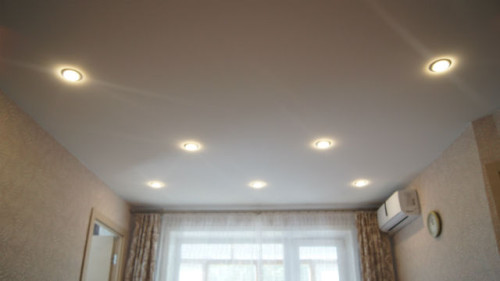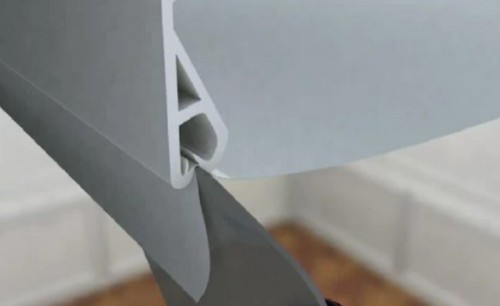Choosing the most suitable method for finishing the ceiling, many prefer stretch fabrics, however, there are several options for the technology: “hot” or “cold” way. If we are talking about PVC panels, installation involves heating the room with a special temperature gun to +70C, which can adversely affect the interior wall decoration. For this reason, the “cold” installation of fabric canvases without heating the room is increasingly practiced. In this article, we will talk about this and tell you how the installation of suspended ceilings without heating is going on.
Content
Characteristics of stretch ceilings without heating
Not so long ago, the only way of decorative decoration of the ceiling was its plaster and whitewashing, then ceiling plates and, finally, suspended ceilings appeared. Depending on the elements of which the suspended structures consist, cassette and stretch ceilings are distinguished. Stretch, in turn, can consist of several elements or be seamless. For their manufacture, a polyvinyl chloride film or special fabric treated with protective equipment is used.
For the installation of PVC paintings, the room must be warmed up properly, since the film tends to expand when heated, and in this state it can be efficiently pulled in high quality and evenly. The fabric, on the contrary, is narrowed when heated, so it is not necessary to heat the room. The fabric canvas is filled in a profile in a pre -set along the perimeter of the room in natural temperature conditions. At the same time, installation does not require the use of professional equipment for suspended ceilings, as in the case of PVC. It is not surprising that stretch ceilings without heating are very popular with those who prefer to engage in repair on their own.
Advantages and disadvantages of stretch ceilings
Fabric stretch ceilings have its own characteristics in addition to installation technology. Compared to polyvinyl chloride, they have a lot of advantages, the main of which many consider seamlessness. So, in order to get a coating of the required size, it is necessary to cook several cuts of PVC film, and the fabric canvas is pulled with a whole piece. Naturally, the material for this is used special. This is a polyester fabric, which is produced in rolls up to 5 m wide, so it is possible to make patterns of various configurations. A qualitatively stretched white cloth forms a perfectly even and smooth surface, completely hiding the technical part of the suspension system.
Note: After installing the PVC ceiling in the room, an unpleasant synthetic smell from a preheated film remains, which has long and difficult to disappear. The fabric cloths do not smell at all.
Also, manufacturers emphasize that the fabric does not prevent natural ventilation in the room, allowing the walls and ceiling to “breathe”. The structure is a small mesh saturated with a protective polymer composition through which air passes unhindered. For this reason, you can carefully hide the ventilation hole under the ceiling without harm to the microclimate of the room.
Seamless stretch ceilings without heating are not afraid of temperature differences, and therefore they can often be found in dry saunas, in kitchens and in other rooms with high temperature. Under extreme conditions, the PVC film is immediately deformed, while the fabric canvas retains its original shape.
Another pleasant moment for lovers to work with your own hands - seamless fabric ceilings can be painted, moreover, more than once. To do this, use acrylic enamel, the limitless color palette of which allows you to realize any design fantasy. One canvas can calmly withstand 8-10 stains, respectively, you can change the walls, furniture, floors in the room, but leave the ceiling the same only by changing its color. PVC film cannot boast of this.
So, what are the main advantages of "cold" stretch ceilings:
- Hide all the shortcomings of the draft surface.
- Resistant to temperature differences (can be installed in the kitchen, unheated balcony).
- Do not require heating the room (simple and faster installation compared to PVC ceilings).
- The possibility of staining in different colors up to 10 times.
- Durability (with high -quality installation, the service life is more than 10 years).
- Resistance to mechanical influences, unlike PVC film, which can be easily pierced or cut.
- Fabric ceilings are not sagging or deformed over time, so they can be installed even in new houses that have not yet had time to shrink.
- Dust does not accumulate on tissue ceilings.
- Safe for human health, animals and the environment.
- Fabric material is not able to react with any chemicals.
- Pathogenic fungal microorganisms and mold do not develop on the ceiling.
- Installations under the canvas of various communications are possible, including lighting and alarm.
- High fireworms (the canvas does not burn and does not support combustion).
Unfortunately, tissue ceilings have their disadvantages. First of all, this is a fairly high cost. The price of stretch ceilings without heating is significantly higher than that of PVC products, however, this amount is more than compensated by durability, aesthetics and functionality. It is also worth noting that for the installation of a “cold” ceiling, more free space should be allocated between the canvas and the base surface, so for low rooms this option is better not to use.
Despite resistance to temperature differences, tissue ceilings are afraid of high humidity, and unlike PVC coatings, they are not able to protect the room in case of leaks from neighbors from above. As a result of prolonged contact with moisture, the fabric ceiling can change its color. If the water has nowhere to evaporate, and it lingers under the ceiling for more than 2 days, the canvas begins to leak.
Another drawback is the complexity of care - if the PVC film can be wiped with a damp sponge, then it will not be easy to remove the stain from the fabric surface. For this reason, such ceilings are best mounted in the living room or bedroom, and not in the kitchen, where there is a high probability of pollution.
So, we can conclude that the fabric ceiling is inferior to polyvinyl chloride only in that it does not save from leaks and requires more complex care. Otherwise, and primarily in installation, this coating is considered the best.
The cost of work
The cost of installing a stretch seamless ceiling is determined by the volume of work, as well as the geometry of the room. So, working with ceilings of a non -standard configuration is much more difficult, and the master can rightly call a higher price for his services. On average, installation of stretch ceilings without heating for a room with an area of \u200b\u200babout 15 m² takes up to 6 hours. But the duration and cost of work also depend on the quality of the walls in the room. So, if they are strong enough, then they are able to hold the profile well, and strengthening is not required. If under a layer of plaster the polystyrene foam with drywall is hidden, installation may require much more time.
Factors affecting the cost of work:
- The materials used - the most expensive are the canvases of German and French manufacturers, the cheapest are Russian and Chinese. The design of the canvas and its protective properties also determine the cost. So, ordinary white products are cheaper than those on which the drawing is printed.
- The configuration of the room - the complexity of the installation depends on the number of angles and the complexity of the ceiling shape.
- Various complicating moments - columns, pipes, irregularities and decorative curvatures, stucco molding, etc.
- Lighting - what lighting will be installed in the room should be considered before installing the stretch ceiling. This can be one chandelier in the middle of the room, multi -level lighting with LEDs or a series of halogen spotlights over the entire area or around the perimeter.
The “clean” installation of a standard stretch ceiling without heating usually costs from 800 to 1500 rubles/m². However, it should be understood that this amount may vary depending on the above factors.
Installation technology
The main feature of the stretch ceilings is the technology of their installation, which differs from the installation of other types of suspended structures of cassette or rack type. In the case of PVC, a building temperature gun is used to heat the stretch ceiling. In more detail, the process of installing such structures is described in the articles "Stretch ceiling in the bathroom: photo, installation features" And "Stretch ceiling in the kitchen: photo, installation features".
In this chapter, we will consider the installation technology in a “cold” way, but first we list the necessary tools and materials:
- a punch or shock drill with a set was ruined;
- a screwdriver (you can limit yourself to a regular screwdriver, but then the work will take much more effort and time);
- a rounded spatula and special shoulder blades for the installation of fabric tensioning canvases (sold in specialized stores, you can order with the canvas);
- building level (better laser);
- ladder;
- maular cord.
In addition to the most fabric canvas, you will need decorative baguettes for seamless ceilings and fasteners (dowels, screws and self -tapping screws). By the way, the dimensions of the canvas should slightly exceed the size of the main ceiling.
Step -by -step installation of a "cold" stretch ceiling:
- First of all, it is necessary to carefully prepare the basic surfaces for installation, and we are talking not only about the ceiling, but also about the walls. To do this, remove the old plaster layer, smear chips and cracks on the black ceiling. After drying, cover the surface with an antiseptic solution, and then moisture -resistant with a primer of deep penetration. So you will strengthen the ceiling plate and reduce the risk of leaks in the event of a flood in the apartment above. Covering the ceiling with a primer and an antiseptic, grab 20-30 cm of the upper part of the walls.
- Take measurements in the room, first measuring the roulette of the perimeter of the room. Next, take a thread or lace and stretch it diagonally from one corner to the opposite, fix the measurements.
- Put the communications and wiring, fixing them to the black ceiling. Experts recommend hiding electric wires and cables in corrugated pipes and only then attach them to the surface. At the same stage, if necessary, secure fire alarm sensors. If you plan to install LED lighting, attach transformers to the ceiling to lower the voltage in the network.
- Mark the baguette frame and fix it with dowels. The step of installation of fasteners depends on the strength of the material from which the walls are made. If it is concrete or red brick, dowels can be installed every 25-30 cm, if less durable material is like wood or gas blocks, the distance between fasteners must be reduced to 15-20 cm. In no case should it be saved on fasteners. In a sense, it is better to “overdo it”, so as not to be afraid that the suspended structure can collapse on the head.
- After installing the frame, you can proceed to pulling the fabric canvas. Before that, notice and wash the floor in the room so that you can expand the fabric on it. Remove the stickers from the unpacked canvas, polyethylene and pick it up by the edges to the bagulate frame using a crocodile (construction clothespin).
- Leave small fabric allowances at the edges (remember that it should be a little larger than the area of \u200b\u200bthe black ceiling) and use a rounded spatula and shoulder blades insert the edges into the baguette. It is most convenient to do this together, filling the canvas at the same time on the opposite sides of the ceiling. Then you can achieve even and the same tension faster and more successful.
- When the fabric is tucked into the baguette, it remains only to cut off the sticking allowances with a clerical knife, pour the edges inside and close these places with decorative ceiling skirting boards.
Summarizes all the above information video on the installation of stretch ceilings without heating:
